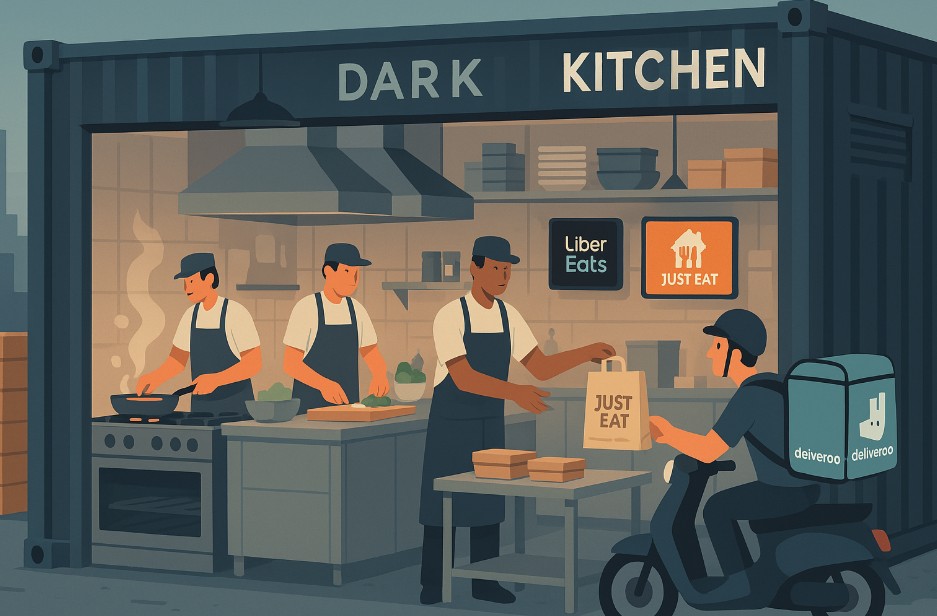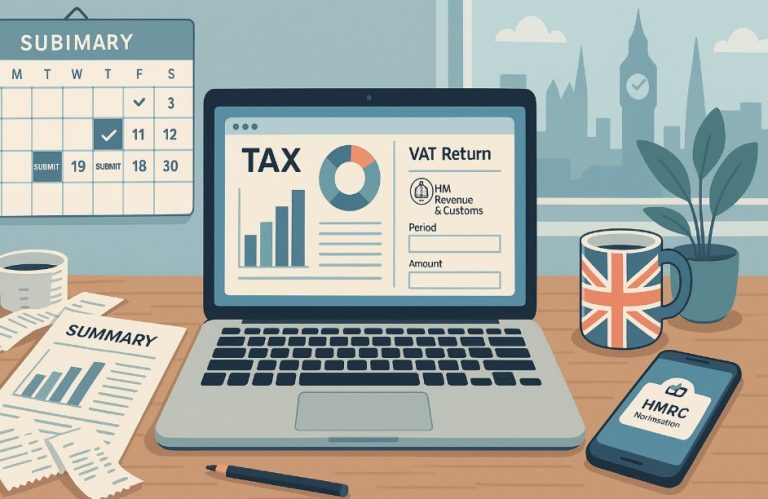What is a Dark Kitchen Business?
How has the food industry adapted to the UK’s rising demand for convenience and delivery? One of the most impactful answers lies in the emergence of dark kitchens a revolutionary concept transforming how food businesses operate.
As online food delivery continues to gain momentum, particularly in densely populated urban centres, many restaurateurs are moving away from traditional high-street setups and embracing a delivery-only model.
According to recent figures, the UK food delivery sector generated over £11 billion in 2023 alone, with projections suggesting even greater growth in the coming years. This shift has opened the door to a new kind of food business: the dark kitchen, also known as a ghost kitchen, cloud kitchen, or virtual restaurant.
But what is a dark kitchen business, and why are so many food entrepreneurs both established and aspiring adopting this model? In this guide, we’ll explore the fundamentals of dark kitchens, examine the most common business models, and discuss the benefits, challenges, and opportunities they present within the UK’s competitive food landscape.
What Exactly is a Dark Kitchen?
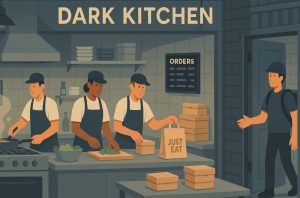
The food industry in the United Kingdom is rapidly evolving, driven by shifting consumer preferences and the growing demand for convenience.
Central to this transformation is the emergence of the dark kitchen, a business model designed specifically to meet the needs of the food delivery market.
A dark kitchen, also known as a ghost kitchen, virtual kitchen, cloud kitchen or delivery-only restaurant, is a commercial cooking facility that prepares food solely for delivery.
These kitchens have no dine-in area or customer-facing space and rely entirely on online orders placed through food delivery apps such as Deliveroo, Uber Eats, and Just Eat.
Dark kitchens have gained significant popularity in recent years, especially during the pandemic, when many restaurants were forced to shut their doors to diners and pivot towards delivery.
As a result, the model has been embraced not just by startups but also by established restaurant chains seeking to expand their reach without the expense of opening a full-service location.
By eliminating the need for front-of-house staff, seating, and high-street rent, dark kitchens enable food businesses to streamline operations and reduce overheads while maximising efficiency and scalability.
How Does a Dark Kitchen Differ from a Traditional Restaurant?
Traditional restaurants are built around the customer experience, from the ambience and decor to the quality of in-person service.
In contrast, dark kitchens are designed for speed, efficiency, and logistical precision, operating behind the scenes to fulfil food orders as quickly and consistently as possible.
One of the most significant differences lies in customer interaction. In a traditional setting, the customer engages directly with the restaurant, whereas in a dark kitchen model, the entire transaction happens online.
There is no physical contact between the restaurant and the customer; the food is ordered through an app, prepared in a remote kitchen, and delivered by a courier.
Operationally, dark kitchens focus purely on the back-of-house. With no need to invest in restaurant interiors, signage or waitstaff, food businesses can operate at a fraction of the cost, often from less expensive locations such as industrial estates or converted shipping containers.
This focus on production and delivery enables faster order fulfilment and more targeted market reach.
What Are the Different Types of Dark Kitchens in the UK?
Just as traditional restaurants range from cafés to fine dining establishments, dark kitchens operate under a variety of models, each catering to different business strategies and customer demands.
Understanding the nuances of these models is essential for entrepreneurs looking to enter or scale in the delivery-only space.
1. The Traditional Dark Kitchen
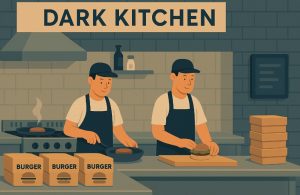
Despite being relatively new, this model represents the standard form of dark kitchen. These operations typically specialise in one specific type of cuisine, such as burgers, salads or pasta, and are optimised for consistency, speed, and delivery.
The operations are centralised in a single kitchen, with the food prepared using streamlined processes. These kitchens may use third-party delivery platforms or their own drivers to fulfil orders.
The concept works best for businesses that want to build a strong identity around a specific food style without expanding into multiple categories.
2. The Multi-Brand Dark Kitchen
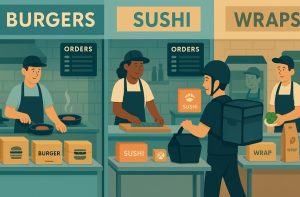
In a multi-brand dark kitchen, several virtual brands operate from the same facility. Each brand has a distinct menu and identity, but they share kitchen equipment, staff and logistics.
This model is increasingly common in urban centres where customer demand for diverse cuisines is high.
Such setups are data-driven, relying heavily on insights into customer preferences, order history and local food trends. Brands can be added, tested or removed with relative ease, offering maximum flexibility.
Although it may require a greater initial investment, the potential for reaching multiple market segments through one operation makes this model highly attractive.
3. The Takeaway Dark Kitchen
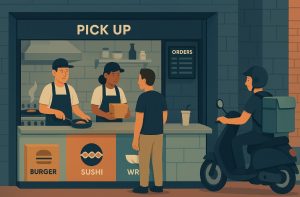
This model bridges the gap between a traditional dark kitchen and a physical takeaway shop. While there is no seating available for dine-in customers, the location allows customers to collect their orders in person.
By offering a visible point of contact, this model enables businesses to build customer trust without the full expense of a high-street restaurant.
It also provides opportunities to upsell, gather feedback and establish a local presence while maintaining the cost benefits of a delivery-focused operation.
4. The Aggregator-Owned Dark Kitchen
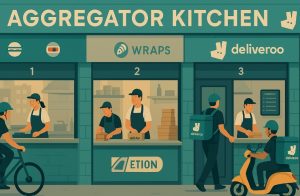
Some of the most prominent food delivery platforms, such as Deliveroo and Uber Eats, have launched their own dark kitchen facilities.
These are typically leased out to restaurant brands that want to expand their delivery footprint without investing in a new site.
Deliveroo’s Editions programme, for example, provides restaurant partners with access to commercial kitchen space, delivery fleets and customer data insights.
Restaurants simply pay a fee to operate within the facility, benefitting from the aggregator’s infrastructure, technology and marketing capabilities.
5. The Aggregator-Owned Dark Kitchen Plus
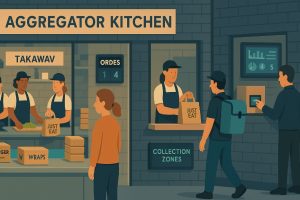
A variation of the previous model, this setup offers additional infrastructure and support, making it even easier for restaurants to launch.
The aggregator might manage logistics, customer service, delivery and even marketing, leaving the restaurant to focus solely on food preparation.
Some of these facilities also include a pickup point or a branded storefront, blurring the lines between a traditional takeaway and a dark kitchen.
The added operational efficiency and reduced administrative load make it a compelling option for new and established food brands.
6. The Outsourced Dark Kitchen
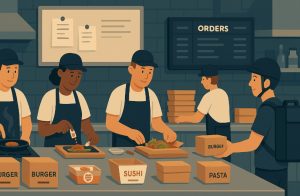
This model represents the most hands-off approach to running a dark kitchen. Restaurants partner with third-party companies that handle everything from cooking to packaging and delivery.
The original business is involved only in menu creation, branding and final presentation touches.
It allows businesses to test concepts or scale operations quickly with minimal investment. Outsourcing can be particularly beneficial for businesses that want to focus on marketing and brand growth rather than daily kitchen management.
How is the Dark Kitchen Model Reshaping the UK Food Sector?
Dark kitchens are playing a transformative role in the UK’s food industry. The rise of delivery culture especially among younger consumers has changed the way restaurants think about their operations, customer acquisition and expansion strategies.
Food delivery is no longer just a supplementary revenue stream. For many restaurants, it is now the primary driver of business growth.
As demand grows, dark kitchens are helping businesses extend their reach, serve new locations, and test innovative ideas at a low cost.
The success of virtual brands has added a new dimension to this model. These are online-only restaurant concepts that operate from dark kitchens, offering limited menus that are optimised for delivery.
Some are entirely new, while others are offshoots of existing restaurant chains.
Brands like Bella Italia’s “Mac Shack” and Las Iguanas’ “Blazing Bird” are examples of how traditional restaurants have used virtual brands to test new food concepts without investing in new venues.
In many cases, a single dark kitchen facility may host half a dozen or more virtual brands, each catering to a different taste or dietary need.
How to Choose the Right Dark Kitchen Model?
Selecting the ideal model requires careful evaluation of your goals, resources, and market conditions. It’s not just about cutting costs it’s about creating a delivery-first operation that aligns with your long-term strategy.
Key considerations include:
- Your level of control: Do you want full ownership of the kitchen and delivery, or would you prefer to outsource?
- Market demand: Does your target location have enough demand for a multi-brand concept, or is a specialised offering more suitable?
- Property costs: Is it more strategic to set up in a city centre with a storefront, or operate from a lower-cost industrial site?
- Operational capacity: Can your team manage high order volumes and multiple brands, or is a single cuisine focus more realistic?
- Legal and compliance factors: Are you ready to meet health and safety standards, food hygiene requirements, and planning regulations?
- Marketing resources: How will you promote your offering digitally, especially without the benefit of foot traffic or visual branding?
Using data to track customer behaviour and performance metrics is key. Dark kitchens provide the flexibility to pivot, adjust menus, test locations, or even switch models if necessary.
What Are the Best Practices for Running a Successful Dark Kitchen?

Achieving long-term success in the dark kitchen space involves more than just cost-cutting. Businesses need to focus on operational excellence, digital branding, and customer experience.
Best practices include:
- Optimising kitchen layout and workflow to minimise order time
- Using technology for real-time inventory and delivery tracking
- Maintaining high food quality despite delivery logistics
- Building strong visual branding through packaging and online presence
- Actively gathering customer feedback to refine offerings
While there is no in-person contact, the customer experience must remain front and centre, from the clarity of the online menu to the condition of the food when it arrives.
Why is the Dark Kitchen Business Model a Smart Move for UK Entrepreneurs?
The dark kitchen model offers unmatched agility in a competitive and fast-changing market.
Whether launching a new brand, testing a concept, or scaling a proven idea, this model enables food entrepreneurs to move quickly, with lower capital and greater flexibility.
With rising urban populations, busy lifestyles, and continued growth in the online food economy, the dark kitchen business model is not just viable, it’s vital.
For the modern restaurateur, it represents a way to innovate, reduce risk, and tap into a market that shows no signs of slowing down.
Conclusion
The rise of dark kitchens marks a profound transformation in how food is prepared, sold, and delivered in the UK.
With increasing reliance on online ordering, changing consumer expectations, and the drive for operational efficiency, dark kitchens offer a flexible, scalable solution for food businesses aiming to thrive in a delivery-first market.
Whether it’s a single-brand kitchen focused on one cuisine, a multi-brand setup catering to diverse tastes, or a fully outsourced operation managed through a third party, the dark kitchen model allows entrepreneurs to adapt quickly, reduce overheads, and meet demand without the costs associated with traditional restaurant spaces.
However, success in this space depends on more than just a clever concept. It requires data-driven decision-making, a strong digital presence, and a commitment to maintaining quality and consistency even without in-person interaction.
For UK entrepreneurs, dark kitchens provide a powerful way to launch, expand, or test new food concepts with less risk and greater speed.
As the market continues to grow, understanding the nuances of this business model and selecting the right approach can unlock significant opportunities in the evolving food delivery ecosystem.
Frequently Asked Questions
Are dark kitchens legal in the UK?
Yes, dark kitchens are legal in the UK, but operators must comply with health, safety and food hygiene regulations and register with their local authority.
What licences are required to run a dark kitchen?
You need to register as a food business, obtain appropriate insurance, and ensure compliance with environmental health standards. Planning permission may be required for certain locations.
Can a dark kitchen become a physical restaurant later?
Absolutely. Many businesses use the dark kitchen model to test concepts before investing in a traditional restaurant setup.
How profitable is a delivery-only restaurant model?
With lower overheads and the ability to scale quickly, delivery-only models can be highly profitable, especially in densely populated areas with high delivery demand.
Do ghost kitchens need a food hygiene rating?
Yes. Like all food businesses, dark kitchens must undergo regular inspections and are subject to the same hygiene rating system.
What’s the difference between a ghost kitchen and a virtual brand?
A ghost kitchen is the physical facility used for preparing food. A virtual brand, on the other hand, is a digital-only restaurant concept that may operate from a ghost kitchen.
Can small food businesses benefit from dark kitchens?
Yes. Dark kitchens offer a low-cost way for small businesses to launch or expand. They can rent space, use shared infrastructure and tap into growing demand without heavy capital investment.

